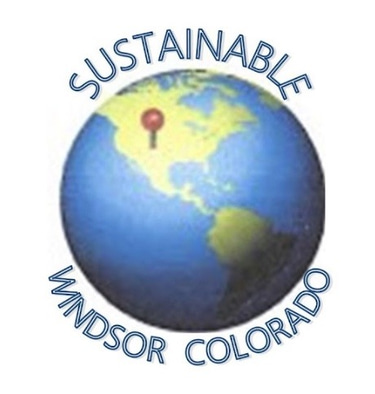Recycling -- Partie Deux
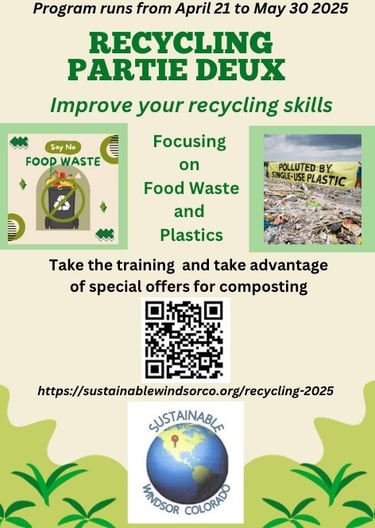

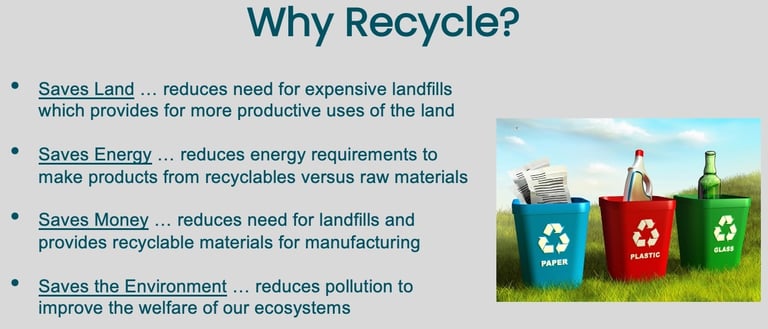

So BUCKLE UP - AND LET'S GET SUSTAINABLE ;-)
And BIG THANKS to Compost Queen, Common Good Compost, and Sistainable Mercantile and Refillery for their "special deals" which will be discussed in the training
... start composting and being more sustainable with some discounts!!
RECYCLING PARTIE DEUX (Part Two)
As part of Sustainable Windsor's projects for 2025 - the Recycling Partie Deux (Part Two) project aims to increase recycling in Windsor and, at the same time, reduce contamination in the recycling process. And this year - our focus is on food waste and plastics - two of the biggest waste diversion challenges we have!
Recycling Partie Deux
... is the 2025 educational offering on sustainability from Sustainable Windsor. The class is designed to educate and inform residents on HOW to be more "sustainable". And it is not difficult to do ...
Given the low rate of recycling in Colorado, this program is intended to increase recycling in Windsor. The program consists of some quick read educational content.
Working with a number of other organizations including Ecocycle and FoCoTrashMob -- Sustainable Windsor has developed a set of training materials which we hope will result in better recycling practices in Windsor (and Northern Colorado in general). And this year - with a focus on food waste and plastic.
We recognize that people learn differently - so we have 3 training approaches:
Web-based - Follow the flow of the training from overview to discussing the challenges, to reviewing the solutions and then advancing to the training summary - Just read this page and then click the "LET'S TALK FOOD WASTE" button below
Document-based - A PDF document that covers the key points of the training and maps to the web-based training. You can find this document at https://tinyurl.com/346ndy4v
Video/Slides - We have also developed a short 25 minute video that can be watched -- the video is here: https://tinyurl.com/y5xftcmf and you can find a PDF version of the slides here: https://tinyurl.com/yk37x6kh
As you will see in the training, Colorado does a poor job on recycling. Though many Northern Colorado residents have recycling provided for them (sometimes as part of their waste hauler agreement - but sometimes at an extra cost) - non-participation and the level of contamination in the recycled materials creates challenges in the recycling process.
This training will start with an review of our recycling training from 2024 and how to be more effective with recycling ... and the concept of Zero Waste.
And the key point is
... it is easy to be better stewards of our planet if you follow a few key steps.
Recycling Simplified
Starts on April 19 2025
And remember to take advantage of the offers from Compost Queen and Common Good Composting
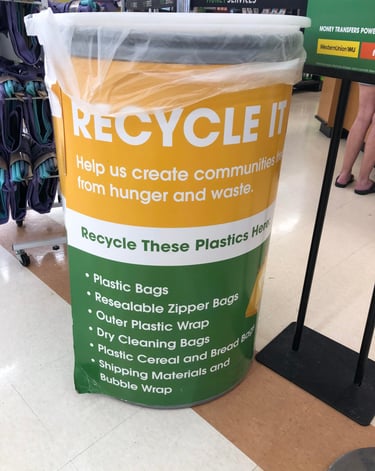

Let's review what we did last year ...
What is Sustainability ?
Sustainability is a long-term goal for society to meet the needs of economic growth at its current speed with the least amount of impact on the environment. But it’s more than preserving the natural world and its fragile ecologies. It’s also about enabling the growth and development of businesses and government entities so that all parts of society work in harmony to ensure that future generations have the natural resources needed to survive.
(from https://www.coursera.org/articles/what-is-sustainability
STATE OF RECYCLING
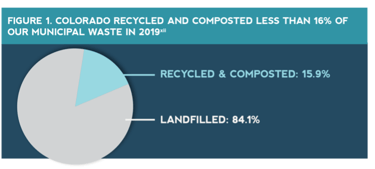

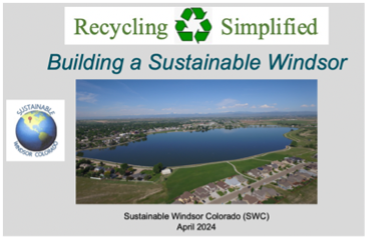

Last year, we focused on general issues around recycling and sustainability. If you want to review the training from last year - please go to the following URL:
https://sustainablewindsorco.org/recycling-simplified
This year – we are focusing on food waste and plastics. These two areas are among the most vexing in terms of management.
With food waste - we live in a society of “plenty” and yet we continue to throw food and organic waste out without thinking – and our landfills are overflowing - causing health issues to local communities and pushing methane into our atmosphere.
Plastic pollution is a nightmare. Each year – we throw away more and more plastic – creating islands of trash in our oceans and requiring us to export our plastic garbage to the furthest corners of our globe.
While Colorado’s waste diversion (e.g. recycling and composting) rate has held steady at around 15% over the past five years, the state’s per capita waste generation has very gradually declined from 6.9 pounds per person per day to 6.4 pounds per person per day.
Most of the state waste diversion is open market based e.g., private hauler trash and recycling. https://ecocycle.org/2025-nyr/. Eco-Cycle suggests the state's low rates of recycling are unsurprising given only half of Colorado's municipalities with 10,000 or more residents provide recycling to households.
Contamination is also a huge issue - Colorado's needs assessment for the Extended Producer Responsibility (EPR) program revealed that 10-20% of recycling is contaminated, causing “equipment downtime, contaminated commodities, lost revenue, worker injuries, increased residue costs, reduced throughput, reduced efficiency and equipment wear and tear.” (The rate includes all materials, not just packaging.) (https://boulderweekly.com/climate/recycling-colorado-producer-responsibility)
Additionally, you would think that recycling makes people consume more wisely. But sadly - people use far more resources (especially paper and plastics) when recycling is an option.
WASTE DIVERSION AND ZERO WASTE
When we did the training last year – one thing was clear … and it was a focus for our training -
People do not know what to throw into recycling
We need to do a MUCH better job on recycling – and avoid contamination. We need to understand that many items cannot be recycled and need to be disposed of differently. We must minimize contamination.
Key points:
Think before you throw …
Know WHAT to throw (and what NOT TO)
Keep organic waste out of recycling
We handed out magnets last year to help people to understand WHAT can and cannot be recycled – and this year we laminated them for people to put on their trash cans.
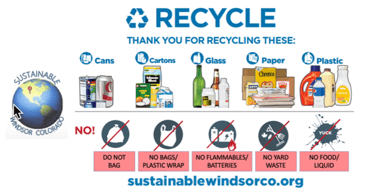

Waste diversion is a complicated area. In today’s world – most of us have “two bins” at home – one for (single stream) recycling and one for all other waste – it would be wonderful if everything people put into the recycling bin was ACTUALLY recycled but that is not the case. In addition to people throwing non-recyclables into the bin – we also see contamination due to food or other materials included with the recycling.
As waste moves through its “lifecycle” - material is moved from the waste hauler to a transfer station and/or Material Recovery Facility.
For all waste that is not recycled – we have two approaches - We bury it in landfills or we destroy it via either incineration or “chemical recycling” (commonly called pyrolysis). If there is not an end market for recycled materials - these “to-be-recycled” items are then directed to landfills or incineration … this is both a tragedy and a missed opportunity.
So what happens to the waste that cannot be processed - we bury it, we burn it, or we destroy it -- and none of these options are good for our planet.
We continue to push more and more waste into landfills. And much of this waste is organic waste – about ~34% of the landfill is food and yard waste. Paper and paperboard waste is next at about 23% - and then we have plastic waste at about 12%. This is why our training is focused on food and plastics – these are two of our key landfill waste categories that we can address both individually and at a policy level. And though landfills “work” currently – they make large swathes of land unusable and they generate toxic gases (including methane) leading to local health impacts and contributing to greenhouse gas impacts.
In terms of burning/destroying waste - currently, the US has over 70 municipal incineration facilities – United States combusts an average of 30 million tons of Municipal Solid Waste (MSW) as per https://www.epa.gov/smm/energy-recovery-combustion-municipal-solid-waste-msw. This does not count non-government incineration facilities e.g. private industry and citizens.
Incineration releases high amounts of particulate matter and Volatile Organic Compounds (VOCs)/toxic pollutants and is tightly regulated by the EPA in terms of emissions. In addition to incineration – we have also seen a rise in using chemical processes to break down waste products – this has become common with plastics for example.
There is a simpler solution – we need to address PRODUCING LESS WASTE …
consumers and industry MUST cooperate on solutions
– especially for food waste and plastics.
Let's discuss the "Circular Economy" and the critical need to move to a Zero Waste framework. The graphic shows a high level view of the circular economy.
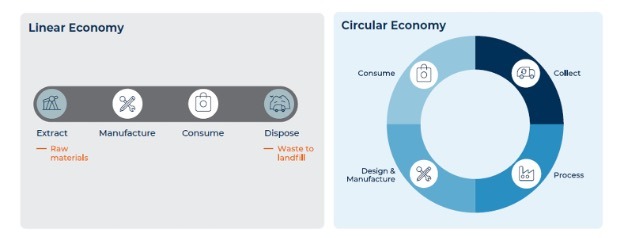

Currently, over half of global greenhouse gas (GHG) emissions come from the extraction and processing of materials, fuels, and food.
Unlike the linear economy (which is how most of our goods are created, used, and then disposed today), a circular economy focuses on providing a circular lifecycle where “used” goods are re-processed back into usable goods.
In the graphic - we see the high level view of a "circular economy". In a circular economy, materials are not wasted (which helps to minimize air and water pollution, climate change, biodiversity, and land degradation).
A circular economy avoids GHG emissions in three ways:
· Less resource extraction
· Reducing upstream emissions from manufacturing and transport
· Reducing methane emissions from landfills
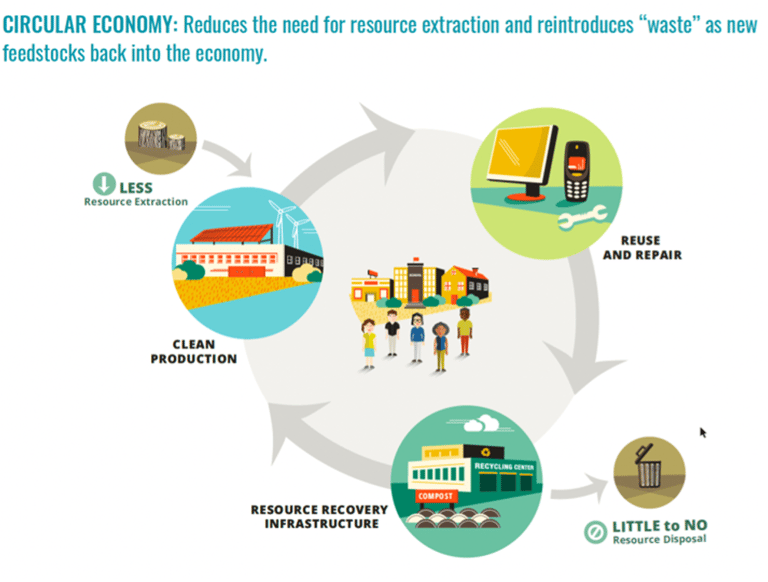

So how do we move to a Circular Economy - let’s take a look at the Zero Waste Hierarchy.
Zero Waste is defined as “The conservation of all resources by means of responsible production, consumption, reuse, and recovery of products, packaging, and materials without burning and with no discharges to land, water, or air that threaten the environment or human health.” (Sources: zwia.org/zwh)
A zero-waste approach focuses on Reducing, Reusing, Recycling and Composting. And this approach underscores the need for policies and campaigns to motivate consumers towards source reduction and reuse.
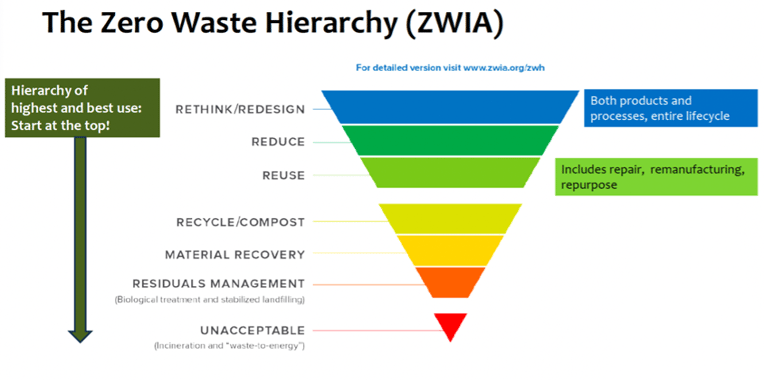

The key point is that …
Recycling should be your LAST option
When you are about to buy something … ask yourself …
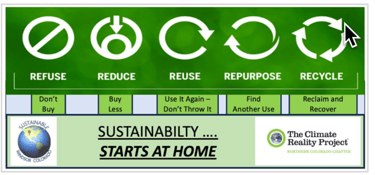

With an honest assessment of this set of questions – each of us can make conscious decisions to act in a more sustainable way
…. And (at the very least) we can do a better job of sorting our recyclables … and understand that each hauler is a bit different - especially with plastics and glass.
BUT the real issue is one of consumption without thinking … we need to be smart consumers
We can all make a difference … and given the current state of our climate - we need to be extra focused on sustainability - at the same time - this is NOT our problem exclusively – corporations must evolve to be better stewards of our globe specifically with respect to plastics and waste diversion in general.
Same time -- we must become better stewards of our planet ...
We need to move beyond our Extract-Make-Buy-Use-Dispose approach and focus on pushing more and more action into implementing a circular economy.
... do you really need the item?
… how much do you really need?
… can you buy a used/secondhand item?
… do you have another item that you could substitute?
… can you buy it in a more “sustainable” format for example aluminum versus plastic?
… is this something you can borrow or rent from someone?
… is there a sustainable way to dispose of the item and packaging?
… can it be reused, can it be re-purposed, can it be “recovered”?
So now that we are done reviewing the "basics"
... let's discuss food waste ....
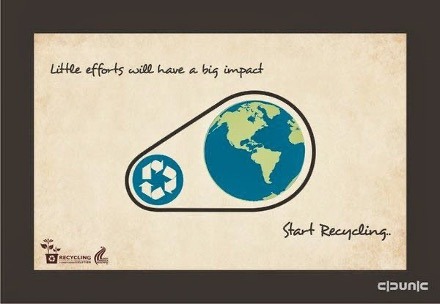

Links to Recycling Parte Deux Training
We have muliple ways to learn about Recycling Partie Deux
If you prefer to watch a video - go to our Recycling Partie Deux Training Video:
The Recycling Partie Deux Training Slides (PDF) with Notes:
If you prefer to read a document - go to our Recycling Partie Deux Training Document:
And ... make sure to download the Recycling Basics Poster
and put it on your refriegrator
